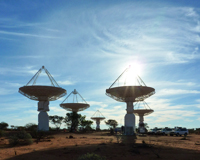OzSKA meeting gets a sneak peek at ASKAP science
9 April 2015
Over 100 astronomers have gathered this week at the University of Melbourne for the OzSKA meeting, a chance to discuss radio astronomy over the next decade and prepare for science with the future SKA telescope.
Over the course of the three-day meeting, discussions include SKA1 science priorities, science already underway with SKA pathfinder instruments – in particular ASKAP and the Murchison Widefield Array (MWA) telescopes – and exploring opportunities for young scientists to become engaged with new projects and ideas.
Included in the invited speakers list are members of the ASKAP Commissioning and Early Science team, who this week unveil some of the initial science data coming from the Boolardy Engineering Test Array (BETA) – currently being prepared for publication in scientific journals in the near future.
BETA commissioning activities provide vital insights in to the intricate workings of the new telescope. As demonstrated in some of the presentations at the OzSKA meeting, this data also gives the team a sneak peek into the capabilities of the full ASKAP telescope, and lays some ground work for some fo the ten ASKAP Survey Science Projects (SSPs) chosen for the first five years of the telescope's operation.
Some of the latest results being prepared for publication include:
- The discovery of a distant radio signal that suggests ASKAP will be able to detect galaxies that other galaxies cannot, using blind HI absorption surveys such as FLASH (the First Large Absorption Survey in HI).
- Observations of a ‘part-time pulsar’ – an intermittent pulsar that spends long periods of time ‘turned off’ – paving a clear path to future transient work, such as VAST (Variable and Slow Transients).
- The discovery of a galaxy accompanied by dark gas clouds – a promising result for the WALLABY project, which will require both sensitivity and resolution to establish how galaxies change over time.
Common to all three projects is that the results would not have been possible without the unique capabilities of BETA (and ultimately, ASKAP) and the radio-quiet environment of CSIRO’s Murchison Radio-astronomy Observatory (MRO) in Western Australia.
The BETA telescope was originally designed for commissioning activities, such as testing the effectiveness of phased array feed (PAF) receivers and learning about ASKAP capabilities. Through ACES, the team is already observing exotic sources, probing niche areas of parameter space and confirming theoretical predictions made with other facilities. These results provide an early insight into what BETA, and ultimately ASKAP, will be able to achieve.
For a full list of speakers, abstracts and the OzSKA meeting program, refer to the CAASTRO website or follow #OzSKA on Twitter.
For more information on the early results presented at OzSKA, read more on the universe@csiro blog.
Back to Latest ASKAP News page.

